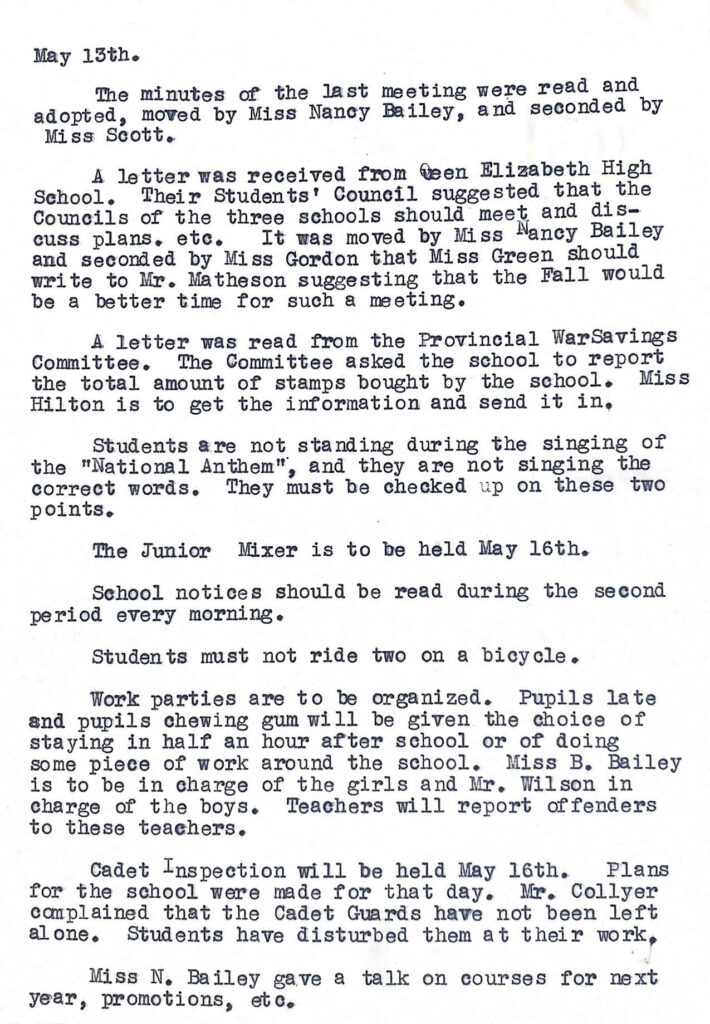
Following the wage suppression that occurred during the Great Depression teachers’ wages were low. Throughout the war teachers attempted to have their wages raised an appropriate amount, as well as asking for a salary schedule, which would allow the teachers guaranteed salary increases in the future. This was further complicated by the Wartime Prices and Trade Board, which put a cap on wages and prices in 1941. L.A. Matheson, the principal of Queen Elizabeth High School, demonstrated just how low teachers’ salaries were through a story about four grade ten boys, who were making a higher hourly wage than their teacher from their summer jobs at a cannery and railroad.1
During the war years BC had a shortage of teachers, a problem that was especially acute in Surrey. The increase in students called for an increase in teachers. In 1943 the student population was more than 3000, creating a need for 100 teachers. Salary issues and teachers leaving due to marriage, joining the war effort, moving to higher paying districts, or changing professions made this a challenge. Previously female teachers would not be permitted to continue teaching once they were married, but due to this shortage an exception was made, with some married women being asked by the schools to continue teaching. It was also quite difficult for the school board to hire new teachers, with many temporary appointments being made.2
One of the many teachers who went on leave in order to join the military was the principal of Lord Tweedsmuir High School, R.N. Stephens. This resulted in Surrey having their first female high school principal, Eva M. Green, who was appointed acting principal. She was later replaced, because the board had felt that all high school principals should be men.3
A member of the BC Teacher’s Federation stressed the damages to student’s education caused by the teacher shortage in Surrey: “No school can be organized on an effective basis so long as teachers are changing positions every year and in many cases every half year.” He stressed that education was particularly important during wartime and shared that the Air Force had to begin giving out special courses to soldiers to address education gaps in many of them. The province reduced the fees and entry requirements for normal school (the teacher education program) in 1944 to address this wartime problem, and increase the number of teachers available.4

Next Page → Wartime Student Labour
References
- “Arbitration Sessions Held in Vancouver.” The Surrey Leader (Surrey, BC, Canada), January 12, 1944. Accessed through Surrey Archives. K. W. Taylor. “Wartime Policies.” Monthly Labor Review 61, no. 2 (1945): 243–56. http://www.jstor.org/stable/41817904. 245-246.; “Teacher Ass’n Asks for Salary Schedule.” The Surrey Leader (Surrey, BC, Canada), May 6, 1942. Accessed through Surrey Archives. ↩︎
- “B.C. Teachers Trying to Have Education Cost Removed from the Land.” The Surrey Leader (Surrey, BC, Canada), January 20, 1943. Accessed through Surrey Archives.; Mary Margaret Sanford Storybook 1915-1991. 2019.0019. Barrie Sanford Collection. Surrey Archives, Surrey, BC, Canada., 18.; “Population of Surrey’s Schools is Over 3000.” The Surrey Leader (Surrey, BC, Canada), October 6, 1943. Accessed through Surrey Archives.; “School Board Find it Difficult to Obtain Teachers.” The Surrey Leader (Surrey, BC, Canada), January 7, 1942. Accessed through Surrey Archives. ↩︎
- “Miss E. Green Now Acting Principal of Lord Tweedsmuir High.” The Surrey Leader (Surrey, BC, Canada), March 19, 1941. Accessed through Surrey Archives.; “Teaching Staff Changes.” The Surrey Leader (Surrey, BC, Canada), June 17, 1942. Accessed through Surrey Archives. ↩︎
- “B.C. Teachers Trying to Have Education Cost Removed from the Land.” ↩︎